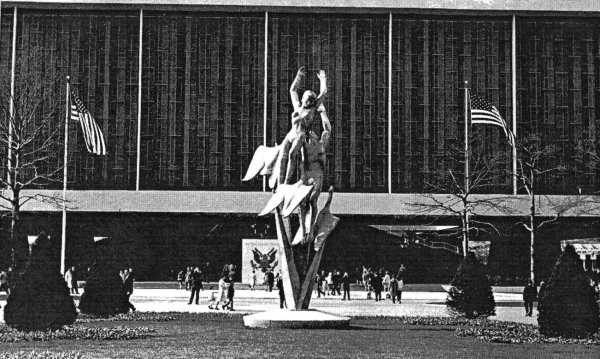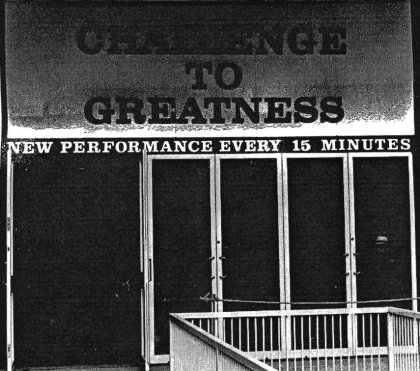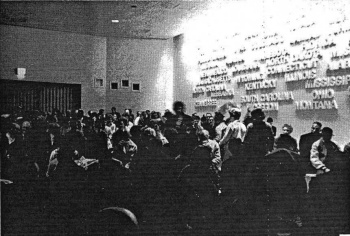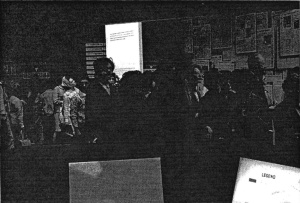-
THE MANY IMAGES OF THE UNITED STATES
A 330-foot facade
of multi-colored glass draws the visitor's eye to the beauty of
the United States Pavilion.
 |
|
-
-
the big show
is a Cinerama "ride" through 400 years of American
History
The late John F. Kennedy endorsed "Challenge
to Greatness" theme of the United States Pavilion. This is
the entrance to the Cinerama "ride" which takes groups
of Fair visitors on "The American Journey."
 |
|
FEATURE SHOW on the top floor
of the huge United States Pavilion is a "ride" with
film that takes the visitor through 400 years of the history
of this nation.
The American Journey, produced by Cinerama, Inc., requires
a dozen 55-seat vehicles which move along a 1,200-foot journey
which passes 110 screens of every shape and size. 159 projectors
(both movie and still) are used to fill the screens with scenes
ranging from the
|
|
depths of the sea to the outer reaches of space. Individual
headsets built into each chair carry the narration ... "here
is our past, look at it!"
An "Environmental" Film
The experience is called an "environmental" film
program, designed to encourage audiences to feel "in"
the events as they happen, to psychologically participate
in the nation's history as it unfolds. The Journey begins
with early scenes of America before the explorers arrived, rolls
on though pictorial highlights on the past, leading up to the
challenges of today's jet age.
|
The "Voyage to America" picture is
shown in this 500-seat theater; Graphic Films collaborated with
John Houseman for this production..
 |
|
There are 19-35mm motion picture, 14-16mm motion picture and
126 Eastman Carousel slide projectors along the ride. Narration
for The American Journey was written by Ray Bradbury; Jeremy
Lepard directed for Cinerama. The musical score is all "Americana"
with sounds of railroad whistles, old tunes, harmonicas and the
like.
|
|
Film "Voyage to America"
Before reaching the Cinerama show, visitors are first received
in a 500-seat theater for a showing of Voyage to America.
This introductory film was produced by Graphic Films Corporation
in collaboration with John Houseman. Its black & white images
utilize both live action and animation to move through America's
Colonial period, to the phase of American Immigration and the
period of Expansion (from 1820 to 1920.)
An original music score by Virgil Thomson, direction by Ben
Jackson, and editing by Pieter Van Deusen of Graphic Films make
this a notable film. It was narrated by Alexander Scourby and
designed to create an understanding and mood of excitement and
confidence in the American way of life -- past, present and future.
This nine-minute black & white film should be made available
to the nation's schools when the Fair closes.
|
Source: BUSINESS
SCREEN MAGAZINE Presented courtesy Eric Paddon Collection
|
The Pavilion's theme "Challenge to Greatness" was endorsed
by the late John F. Kennedy. It is exemplified in a Pavilion
area of "Challenge" through which visitors walk on
their way to the Journey film. Here several hundred other
displays include continuous films shown at the bottom of a "well"
set in the floor of the United States Pavilion. |
Films are also projected in several "wells"
in the U.S. Pavilion; here they are shown on side walls by overhead
repeater projectors.
 |
|
|